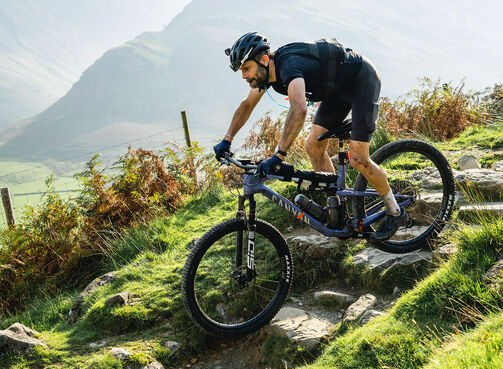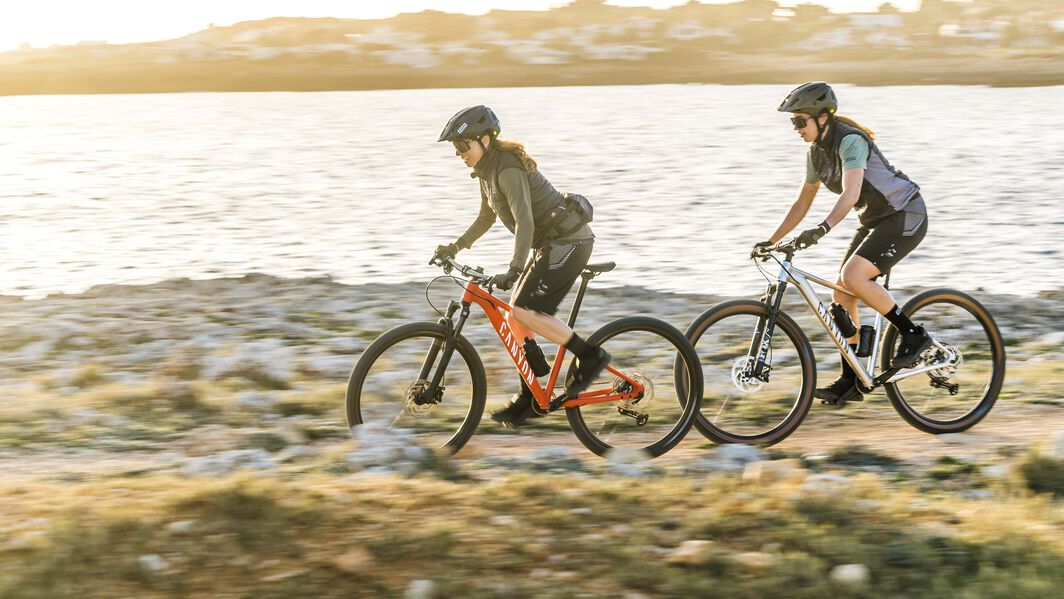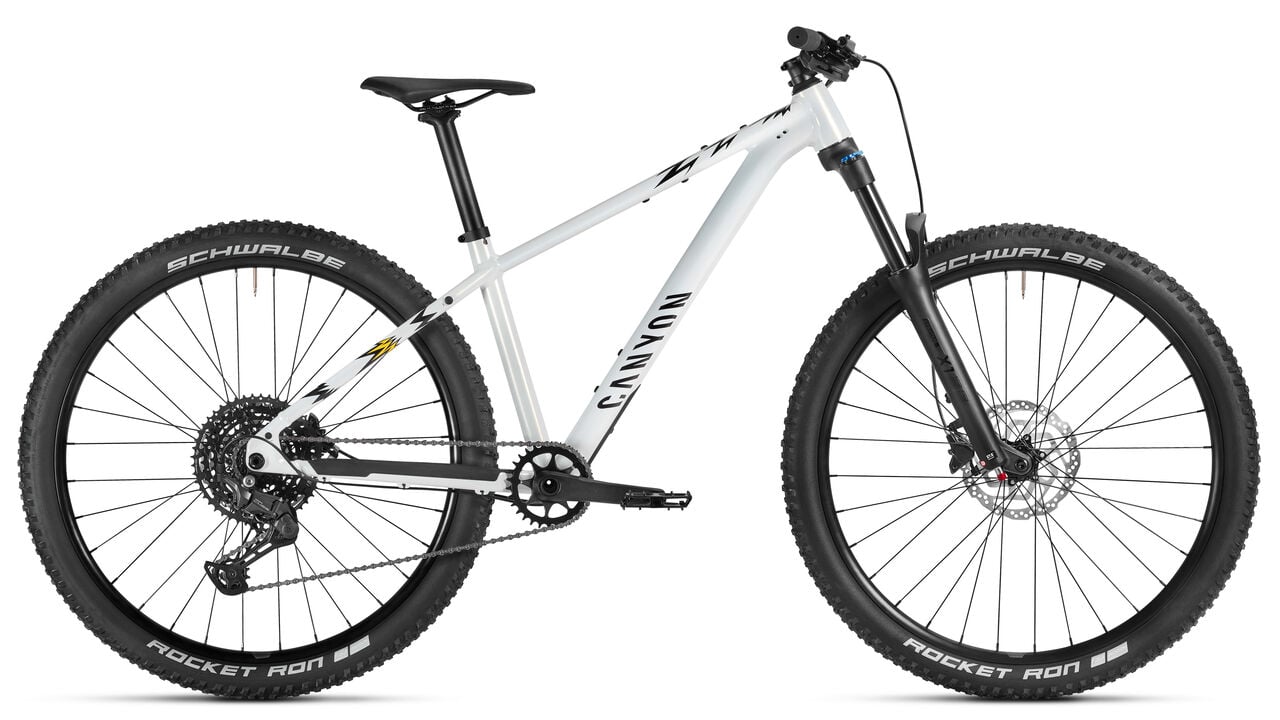Hardtail vs full suspension - Which is right for you
Confused between hardtail and full suspension mountain bikes? Discover the key differences, pros, and cons to find the best fit for your riding style and terrain.


Hardtail vs full suspension is a debate almost as old as mountain biking itself. While the first mountain bikes were fully rigid, the early pioneers did not take long to try adding suspension to their bikes. Soon many wild and wonderful designs emerged, some of which worked and some didn’t. Back then it was the Wild West of bike design and it was a serious question as to whether each new design would surpass the hardtail, or add new and unforeseen complications.
Today, most of our mountain bike athletes choose to race on full suspension bikes, but for some people, hardtails are still the best choice. Whether you are an experienced rider looking to weigh your preferences or are new to the sport and are trying to understand what people are talking about, this guide will walk you through the steps to finding the right style of mountain bike for you.
Contents
What is a hardtail mountain bike?
In the simplest terms, a hardtail mountain bike is a bike with a rigid, one-piece frame with a suspension fork at the front. We call them hardtails because they have no suspension at the rear, and to differentiate them from rigid mountain bikes with no suspension at all. We offer front suspension on (almost) all our mountain bikes because we think the extra comfort and fun of a suspension fork is a good investment.
What is a full-suspension mountain bike?
Full suspension mountain bikes have more complex frames to allow the rear wheel to move out of the way of obstacles and absorb vibration. This is controlled by a shock absorber that can be tuned to give different riding characteristics. They tend to be a little bit heavier than hardtails but offer a lot more comfort and control for challenging trails.
Why is a full suspension bike not called a softtail?
In the past, there were bikes called softtails too, which were hardtail frames with a small, basic damper built into the rear of the frame. In an era when full suspension systems could be a lottery, they were seen as a compromise to give a little more comfort without the complication. While they did cut out some vibration, they also tended to make the frames feel quite wobbly. Today, when full suspension mountain bikes are extremely good, few people still make softtail mountain bikes. Many young riders will likely never have heard of them, although this technology is now seeing a resurgence on some gravel bikes.
How to choose between a hardtail and a full suspension bike?
One of the great things about mountain biking is that you get to decide what is fun for you. There is no right or wrong answer as to whether you choose a hardtail or a full suspension bike - because with either decision you get a mountain bike to ride after. That said, we have noticed that people tend to make their decisions based on three main things:
Rider preference
Some people just like hardtails. Many mountain bikers started on simple hardtails, and maybe they take them back to a freer, more innocent time in their lives. If you are an experienced rider, you may want an efficient cross-country race machine, a dedicated trials rig, or a precise dirt jump bike. There are lots of reasons for choosing a hardtail, but we think the best is simply that they can be a lot of fun for the right rider.
Budget
We work hard to make our full suspension mountain bikes great value for money. That said, there is no getting away from the fact that it costs more to make a full suspension bike. If you are on a tight budget, then a hardtail might be the only option available. We work hard to make sure that every bike we make is great to ride, so that even if you are limited on budget you won’t be limited on fun (Check out our quick guide to finding a fun, budget-friendly mountain bike for beginners).
Simplicity
Some people love hardtails because they are simple. The frame has no moving parts, so there is less maintenance with fewer parts to service or wear out. Full suspension bikes will need annual servicing for the rear shock and over time the bearings and other hardware will need replacing.

Hardtail or full suspension for a new mountain bike rider?
For riders new to the sport, or just looking for easy bikes to have fun on, we think the Grand Canyon and the Neuron would be great choices.
The Grand Canyon is the most affordable bike we make and the quintessential simple hardtail. With a 120mm suspension fork at the front, multiple storage options and modern geometry, it is built to take you from your local trails to alpine epics.
Riders looking for a full suspension bike might consider the Neuron. Available in high-performance carbon or affordable aluminium, it is our most accessible full suspension bike. Designed to be comfortable and easy to handle, it too will handle everything from your local trails to as big an adventure as you can dream of.
Hardtail or full suspension for trail riding?
If your trail needs are more advanced, then the Stoic and the Spectral might be your perfect partners. Designed around progressive geometry and sturdy components, they are designed for all the thrills of trail riding.
If you want all the bang for as few bucks as possible, the Stoic might be the right mountain bike for you. With a long reach, slack head angle and a bombproof build, it has everything for jumps, drops and whatever else the trail may throw at you.
The Spectral is the heart of our mountain bike range, it is a trail-shredding, award-winning full suspension bike. With aggressive geometry and progressive suspension, it is designed for anything and everything that trail riding might mean to you. It is available in both a value-focused aluminium version and a feature-packed carbon option.
Hardtail or full suspension for cross-country racing
Hardtail or full suspension is still a huge debate in the cross-country world. Which one is right for you will depend on your racing and riding priorities.
In recent years, full suspension bikes have begun to dominate World Cup racing. As suspension designs have got lighter and more efficient, the trade-offs for taking front and rear suspension have been getting smaller, and the extra comfort and traction make a huge difference in longer races. With a shockingly light 1,535g frame weight, we think the Lux is the pinnacle of cross-country racing bikes.
If uncompromising power delivery and lightweight is your thing, then the Exceed might be the bike for you. Quite simply, nothing puts the power to the ground quite like a cross-country race hardtail. Maybe you are not certain you want to go all-in on racing and can justify the Lux? The Exceed is a more affordable option that will certainly not hold you back on race day.
Hardtail or full suspension for enduro racing?
We are big believers in riding the bike you have. So if you want to try your first enduro race, you can go and try on whatever bike you have. Both the Spectral and the Stoic would be perfect for a first race if you don’t have the budget for a dedicated race bike. But, if you want to get serious in a sport where suspension travel can be a big advantage, we think you need a full suspension bike.
We make just one dedicated enduro race bike - the full suspension Strive. Designed and developed at the highest levels of competition for more than a decade, it is the bike of choice for our fastest enduro racer

Two styles, one goal - ride your way with Canyon’s hardtail and full-suspension MTBs.
- Hardtail MTBs: Light, efficient, and ideal for climbs and smoother trails.
- Full-suspension MTBs: More control and comfort on rough, technical terrain.
Hardtail or full suspension for downhill?
Hardtail or full suspension for dirt jumping and trials?
Dirt jumping is one of the few areas of mountain biking where there is a definite advantage to running a hardtail. Where precision and simplicity are key, a hardtail like the Stitched 360 is the only choice for serious dirt jumpers.
If you want to emulate Fabio Wibmer and Tomomi Nishikubo and try your hand at trials, then you will definitely need a hardtail like the Stitched Trials. In trials, absolute precision is a must, so a simple but tough hardtail is always the best bike. That is why this is the only mountain bike we make with a rigid fork.
What's the ideal wheel size for hardtail and full-suspension bikes?
We design our bikes with a specific rider in mind. We think about what kind of trails they might enjoy and how they might want their bike to feel in those situations. For some of our bikes, like the full suspension Neuron, most of the range comes with 29” wheels as we think they are the best choice for all-day rides. For the S and XS bikes, we fit them with 27.5” wheels front and rear as we think they will be more comfortable for smaller riders. That decision is based on who we think will ride the Neuron, not whether it has suspension or not.
Hardtail vs. full-suspension: A quick roundup of pros and cons
To sum it up, here’s a side-by-side look at the main features of hardtail and full-suspension bikes – so you can see what each type has to offer.
Full suspension
| More comfort | More expensive |
|---|---|
| More control on rough terrain | Less control on rough terrain |
| Looks cool | Heavier |
Hardtail
| Simple | Less comfort |
|---|---|
| Less control on rough terrain | Less control on rough terrain |
| More affordable |
There’s no right or wrong - just what suits you best. Think about where and how you’ll be riding, and you’ll find the mountain bike that fits your needs.
To help you decide, explore our detailed MTB buying guide showcasing Canyon models and their key features, and use our bike comparison tool to easily compare specs and find your perfect match.
What if I am still not sure?
Choosing the right bike can be both fun and really difficult, especially if you are on a tight budget. If you are still not sure whether you need a hardtail or full suspension mountain bike, then we would recommend visiting one of our Experience Centres. Our friendly and knowledgeable team will be happy to talk you through the different models and even organise test rides for you to help find your perfect bike, whether you want suspension or not.
Discover our Mountain Bikes
Did this article help?
Thank you for your feedback
-
 About the author
About the authorMatt Wragg
Get to know Matt Wragg, the freelance photographer, writer, and self-proclaimed bicycle-breaker based in Nice, France. Despite unsuccessful attempts at XC, trials, 4X, and DH racing, Matt's passion for mountain biking never waned. After a stint in communications consulting, he decided to pursue his love for cycling and moved to New Zealand. Since then, he has traveled the world, chasing trails and building a successful career as a cycling photographer and writer. In 2021, he was diagnosed as autistic and has been coming to terms with it. His bike cellar is a true testament to his love for cycling, housing bikes that range from freeride to cargo.

















